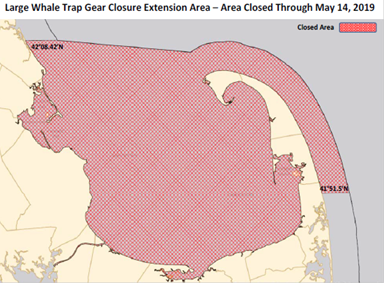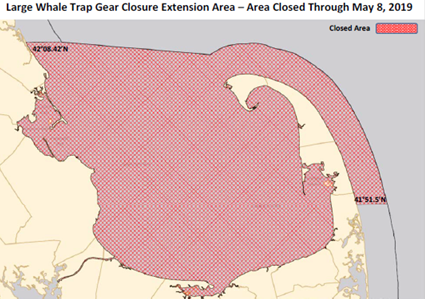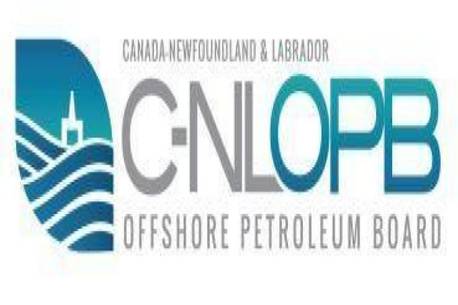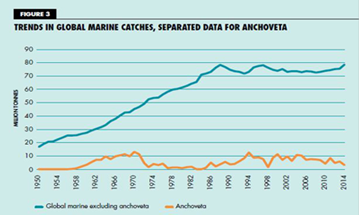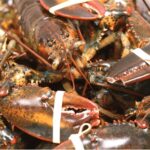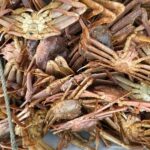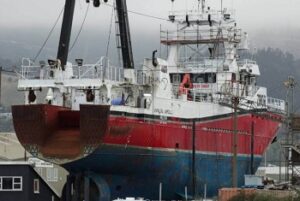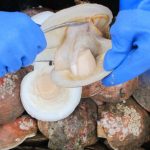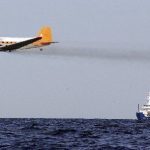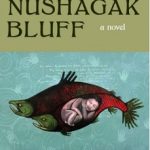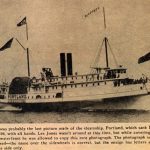Search Results for: plankton
Seasonal Trap Gear Closure Extended Through May 14th
The continued presence of endangered right whales in the waters off Cape Cod results in the Director of the Division of Marine Fisheries extending the seasonal Large Whale Seasonal Trap Gear Closure through May 14, 2019 (Notice of Declaration)> click to read< This closure extension applies only in certain waters within Cape Cod Bay and along the Outer Cape. This extended closure only applies within those waters under the jurisdiction of the Commonwealth within Cape Cod Bay south of 42° 8.42’ north latitude and east of Cape Cod north of 41° 51.5’ north latitude at Nauset Light (see map). This closure does not extend into any federal waters, including those waters north of Cape Cod on Stellwagen Bank. Accordingly, both recreational and commercial trap fishermen are prohibited to setting any trap gear in these waters until May 15th.
Recent aerial surveys by the Provincetown Center for Coastal Studies demonstrate that right whales remain in the waters of Cape Cod Bay feeding at or near the surface in Cape Cod Bay. Additionally, Calanus plankton counts indicate that the whales are likely to remain aggregated and feeding in the area. DMF will continue to closely monitor the presence of whales off Cape Cod and the duration of trap gear closure extension may be shortened or extended in response. DMF will update the public regarding any such adjustments.
Right whales are critically endangered species and their population has been decreasing since 2010 due to continued mortality and low birth rates. These whales seasonally migrate into Massachusetts waters and aggregate in Cape Cod Bay to feed on zooplankton. In recent years, more than 50% of the known right whale population were observed in our waters during late winter and early spring. This trap gear closure extension protects these endangered whales from entanglements in fixed fishing gear, which are a major source of mortality for these animals.
For more information about the management of protected species in Massachusetts, contact DMF at 617-626-1520 or visit our website at www.mass.gov/marinefisheries.
Mass Div. Marine Fisheries Advisory: Seasonal Trap Gear Closure Extended Through May 8th
Fri, Apr 26, 2019 at 2:37 PM
Marine Fisheries Advisory
Seasonal Trap Gear Closure Extended Through May 8th
The continued presence of endangered right whales off Cape Cod results in the Director of the Division of Marine Fisheries extending the seasonal Large Whale Seasonal Trap Gear Closure through May 8th (Notice of Declaration) for certain waters within Cape Cod Bay and along the Outer Cape. This extended closure only applies within those waters under the jurisdiction of the Commonwealth within Cape Cod Bay south of 42° 8.42’ north latitude and east of Cape Cod north of 41° 51.5’ north latitude at Nauset Light (see map). This closure does not extend into any federal waters, including those waters north of Cape Cod on Stellwagen Bank. Accordingly, both recreational and commercial trap fishermen are prohibited to setting any trap gear in these waters until May 9th. The duration of this closure extension may be shortened or extended based on continuing aerial and vessel based surveys and fishermen will be notified of any such adjustments.
On April 25, 2019, the Provincetown Center for Coastal Studies conducted an aerial survey for right whales along Cape Cod. The survey estimated there were approximately 57 right whales feeding at or near the surface in Cape Cod Bay. Additionally, Calanus plankton counts are high indicating that the whales are likely to remain aggregated in the area to feed. This trap gear closure extension protects these endangered whales from entanglements in fixed fishing gear, which are a major source of mortality for these animals. Right whales are critically endangered species and their population has been decreasing since 2010 due to continued mortality and low birth rates. They seasonally migrate into Massachusetts waters and aggregate in Cape Cod Bay to feed on zooplankton. In recent years, more than 50% of the known right whale population has been observed in our waters during late winter/early spring.
For more information about the management of protected species in Massachusetts, contact DMF at 617-626-1520 or visit our website at www.mass.gov/marinefisheries.
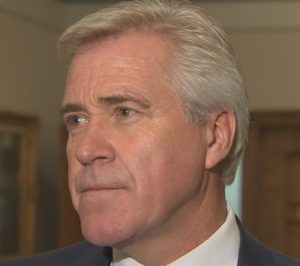
FISH-NL condemns $20 million in spending on seismic blasting; Grand Banks ‘desperate’ for a break
The Federation of Independent Sea Harvesters of Newfoundland and Labrador (FISH-NL) condemns the decision by the Dwight Ball government to spend another $20 million this year on seismic blasting in the province’s offshore. “The Grand Banks are desperate for a break,” says Ryan Cleary, President of FISH-NL. “Most commercial fish stocks are in hard shape, and plankton numbers are way down. Ottawa preaches caution with fisheries management, and Dwight throws that caution over the side of a seismic boat.” >click to read<10:48

FISH-NL condemns $20 million in spending on seismic blasting; Grand Banks ‘desperate’ for a break
FOR IMMEDIATE RELEASE Wednesday, April 17th, 2019
The Federation of Independent Sea Harvesters of Newfoundland and Labrador (FISH-NL) condemns the decision by the Dwight Ball government to spend another $20 million this year on seismic blasting in the province’s offshore.
“The Grand Banks are desperate for a break,” says Ryan Cleary, President of FISH-NL. “Most commercial fish stocks are in hard shape, and plankton numbers are way down. Ottawa preaches caution with fisheries management, and Dwight throws that caution over the side of a seismic boat.”
The 2019 provincial budget includes $20 million for seismic work, $8 million less than than the year before. Since 2011, the province has spent $179.4 million to gather seismic data, which is used to spur private interest in the offshore oil industry.
As many as four seismic vessels are expected to operate off Newfoundland and Labrador in the coming months. The process involves towing air guns that blast compressed air through the water and into the seabed to determine whether oil and gas deposits are below.
Seismic surveys produce the loudest human-made sounds in the ocean, with the noise travelling up to 3,000 kilometres. Harvesters have long said that seismic blasts interrupt the migratory pattern of fish stocks, and a 2017 Australian study found that seismic testing can destroy plankton, the basis of the marine food chain.
In December, a senior scientist with the Department of Fisheries and Oceans in St. John’s revealed that plankton productivity in waters around Newfoundland and Labrador has plunged by 50 per cent in the past four or five years.
Three of DFO’s four science briefings so far this year on northern cod, caplin and shrimp noted that declining plankton numbers are having an impact on stocks.
“The Grand Banks are on their knees, and the Dwight Ball government could care less,” said Cleary.
In January, FISH-NL called on the Canada-Newfoundland and Labrador Offshore Petroleum Board, which regulates the offshore industry, to suspend seismic work until more research is carried out. The Board turned down the request.
Contact: Ryan Cleary 682 4862
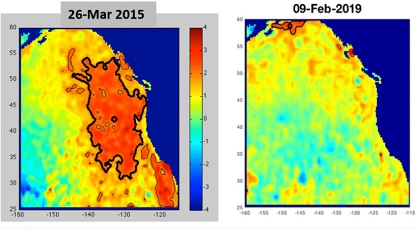
Cooling California Current could mean good news for fisheries, ecosystems
Ocean currents off the Northern California coast are cooling down — potentially good news for the region’s fisheries and ecosystems, battered in recent years by warm currents that have triggered a range of disruptions, from faltering salmon runs to a devastated kelp forest and abalone populations. In a report on the California Current, NOAA scientists last week said that cooler water has resulted in improved condition of zooplankton – the foundation of the ocean’s food chain – greater juvenile salmon returns, and bigger anchovy schools, a boon to larger fish and whales. On the other hand, scientists said,,, >click to read<20:24
FISH-NL: C-NLOPB ‘waking up’ to concerns over impact of offshore seismic activity
FOR IMMEDIATE RELEASE Friday, Feb. 22, 2019
The Federation of Independent Sea Harvesters of Newfoundland and Labrador (FISH-NL) is frustrated the Canada-Newfoundland and Labrador Offshore Petroleum Board isn’t prepared to suspend offshore seismic work, but encouraged the offshore oil and gas regulator is waking up to concerns.
“Ottawa takes a precautionary approach to fisheries management — which means being cautious when science is uncertain — but there’s nothing precautionary about allowing seismic to continue until the potential risks are understood. ,” says Ryan Cleary, President of FISH-NL. “The hypocrisy doesn’t escape inshore harvesters.”
In a Jan. 8th letter, FISH-NL implored the C-NLOPB to proceed with extreme caution and immediately suspend seismic work off Newfoundland and Labrador until the activity can be reevaluated.
FISH-NL pointed to recent research out of Tasmania that concluded the intense acoustic signals used in oil and gas exploration caused significant damage to zooplankton populations that are critical elements of the marine food chain — and seismic activity in waters around Newfoundland and Labrador has increased dramatically in recent years.
In a Feb. 13th response, Scott Tessier, Chair and CEO of the C-NLOPB, said the board is “fully aware” of the Tasmania research and has been in direct contact with the Australian offshore regulator — the National Offshore Petroleum Safety and Environmental Management Authority.
Tessier pointed out the C-NLOPB relies on DFO to provide advice on the conservation and protection of fisheries and marine ecosystems.
“DFO’s assessment is that it’s not possible to establish a correlation between recent changes in plankton abundance throughout Atlantic Canada and seismic surveys carried out in parts of the region,” Tessier wrote.
He added discussions are underway within the federal government “on reviewing and potentially updating” the Statement of Canadian Practice with respect to the Mitigation of Seismic Sound in the Marine Environment, which is incorporated in the C-NLOPB’s geophysical, environmental and geotechnical program guidelines.
FISH-NL also raised concerns about the “cozy” relationship between oil companies, the FFAW-Unifor, and the C-NLOPB.
The FFAW-Unifor has been receiving at least $50,000 a year from oil companies to fund its petroleum industry liaison position, along with another $25,000 a year from the C-NLOPB, which would appear to be a blatant conflict of interest.
Tessier said the C-NLOPB discontinued its $25,000 annual allocation in 2018 “in light of new approaches developed by governments to participant funding programs and evolving stakeholder engagement approaches by governments and the Board.”
“That seems to be a ’round about way of confirming the conflict existed and has been addressed,” said Cleary. “That just leaves the conflict between oil companies and the FFAW.”
-30-
Contact Ryan Cleary: 682 4862
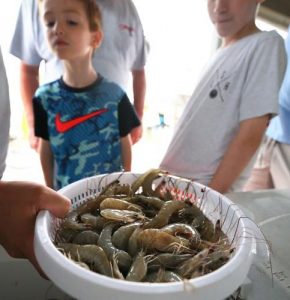
Will South Carolina shrimp season delay pay off with big crop this fall?
The first of the fall white shrimp are coming in — and they’re coming in surprisingly big. Shrimpers and customers are edgily anticipating these next few months as they await the bounty harvest that makes or breaks a season. But whether big shrimp this early is a good sign is anybody’s guess after this year’s opening was delayed and the summer catch was spotty. “Who knows? This has been such a wacky season,” said Rutledge Leland of Carolina Seafoods in McClellanville. Big fall shrimp this early could mean there just aren’t that many of them out there, he said. But Shem Creek shrimper Tommy Edwards thinks the early shrimp are promising after the relentless July storms. Rains promote algae and zooplankton, which shrimp feed on. >click to read<19:47
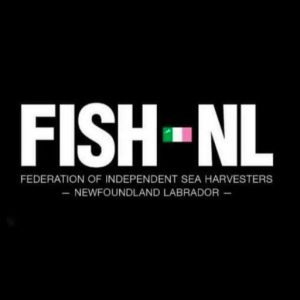
FISH-NL calls for IMMEDIATE ACTION on northern cod, including moratorium on seismic; harvest of more seals
The Federation of Independent Sea Harvesters of Newfoundland and Labrador (FISH-NL) recommends Ottawa follow scientific advice on northern cod and restrict removals from all sources to the lowest possible level until the stock clears the critical zone.
FISH-NL also calls for an immediate freeze to all scheduled offshore seismic activity off the province’s east coast, support for the taking of the entire seal quota, the introduction of tags in the food fishery, and the ordering of an independent review of “epic” federal fisheries mismanagement in the Newfoundland and Labrador region.
“It would be utterly useless, and an insult to inshore harvesters for the federal government to solely introduce restrictions to the commercial fishery when their own scientists say fishing isn’t the problem,” says Ryan Cleary, President of FISH-NL.
“Ottawa must address all elements of the current fisheries crisis. Fishing nations around the world have their eyes on Canada and northern cod to see if they screw this up again,” he added.
“It’s not too late for the Government of Canada to do the right thing, and redeem itself in the eyes of the province and the world.”
The federal Department of Fisheries and Oceans (DFO) held a meeting in St. John’s this week to gather advice on the 2018 northern cod management plan.
The advisory meeting follows news in March from DFO’s scientists that the cod stock had declined about 30 per cent from 2017-2018. Scientists say the stock is in far worse shape today than in 1992 when the moratorium was called. They also predict the stock will continue to decline in 2019, even with zero fishing effort.
Recommendations put forward during this week’s advisory meeting included eliminating the 2018 food/recreational fishery entirely, and cutting commercial cod catches by as much as half — to 5,700 tonnes this year from 12,200 tonnes landed in 2017.
The advice will be passed on to federal Fisheries and Oceans Minister Dominic LeBlanc, who is expected to unveil this year’s northern cod management plan in the coming weeks.
FISH-NL recommends an immediate suspension of seismic work in waters off Newfoundland and Labrador — a recommendation it first made in June 2017.
At the time, a new report suggested the intense acoustic signals used in oil and gas exploration cause significant damage to zooplankton populations that are critical elements of the marine food chain. FISH-NL’s request was turned down by the Canada/Newfoundland and Labrador Offshore Petroleum Board.
In 2017, the amount of seismic activity off Newfoundland and Labrador was described as “super sized,” with the Dwight Ball administration acknowledging only this week it ordered Nalcor to spend $20 million on seismic last year alone.
In terms of the impact on northern cod of the estimated 7.4 million harp seals off the province’s east coast, inshore harvesters call for immediate action.
FISH-NL supports 100 per cent utilization of the animals (as opposed to a cull), and advises Ottawa to encourage/support the harvest of the entire 400,000 quota (only about 70,000 were taken last year), and plan to further expand the hunt.
FISH-NL also recommends Ottawa move to increase the number of commercial sealing licences.
As for the food/recreational fishery, FISH-NL advises Ottawa to introduce a tagging system to keep track of removals. Ottawa estimates just over 12,200 tonnes of northern cod were taken in the 2017 commercial fishery, but there are no estimates on the total take from the food fishery.
Finally, FISH-NL reiterates its call for an independent investigation of the “epic” mismanagement of northern cod, including the relationship between DFO and the FFAW-Unifor.
The 2016/17 northern cod management plans were developed — not by DFO, which has the constitutional responsibly — but by a private entity led by the FFAW-Unifor and west coast Newfoundland fish processor Bill Barry.
The so-called Groundfish Industry Development Council (GIDC) developed the management plans (which included the elimination of IQs or individual quotas in favour of weekly limits) with zero input from inshore harvesters.
DFO abdicated its management responsibility, and the GIDC (chaired by Jim Baird, a retired DFO director general for the NL region) devised a plan that resulted in further stock decline. Baird did not attend this week’s advisory meeting.
Said Cleary, “The federal government abdicated its constitutional responsibility for fisheries management, resulting in a management plan that once again failed the fish, failed our rural communities, and failed our inshore harvesters.”
Contact: Ryan Cleary 682 4862
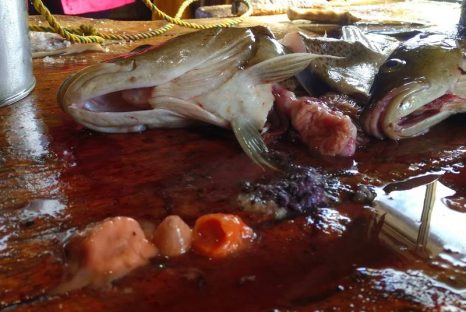
Cod facing ‘natural mortality’ or starvation?
Now that DFO has announced that the cod stocks have declined due to “natural mortality” — a nice way of saying no one is responsible — I take the liberty of posting a few shots I took in 2017 to show what I call starving cod and the contents of their stomachs. Related story: Northern cod stock declined over last year; scientists urge minimum fishing effort >click to read< Not sure of other people’s experiences last year, but this is typical of the cod I caught. I can only speak for myself. See the sea anemones and the blackberry (zooplankton) in one photo and I was surprised to find nothing but a welk in another cod. David Boyd >click to read<22:21
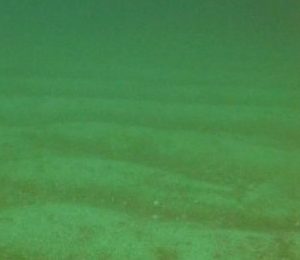
Huge herring spawning ground discovered in Wester Ross
A huge spawning ground for herring has been discovered near Gairloch in Wester Ross. The ground, thought to be around three square kilometres, was discovered by scallop divers who operate in the area. Scientists from Marine Scotland are examining egg samples from the site to try to identify their genetics. Overfishing has long been considered the main reason herring numbers fell sharply. But more recent research suggests climate change affecting plankton,, >click to read<20:22
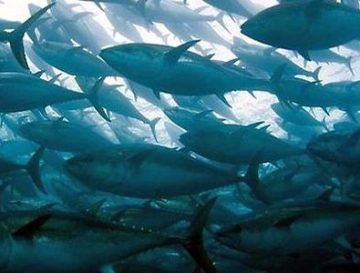
Study finds tuna fishermen who fish along ocean fronts can significantly boost revenue
These oceanographic conditions are more complex than simply being warmer temperatures, said James Watson, an OSU marine ecologist and lead author on the study. Their technical name is Lagrangian Coherent Structures, though scientists often refer to them as “the skeletons of the sea.”“Essentially they are physical ocean fronts where surface waters converge,” Watson said.,, “What we’ve found is that the stronger the convergence, the more likely it is to attract certain things, beginning with the aggregation of phytoplankton, which in turn attracts larger organisms like tuna – and, ultimately, tuna fishermen.” >click to read<12:25
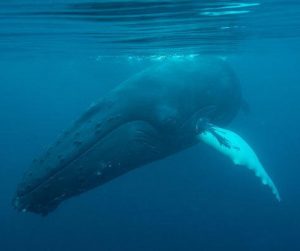
Seismic Surveys Planned Off U.S. Coast Pose Risk To Marine Life
Animals that live in the ocean communicate with sound — humpback whales, for example. But these voices could soon be drowned out by powerful sonic booms from vessels searching for oil and gas. President Trump is opening up the Atlantic Coast to companies to explore for fresh reserves. And to explore, they will be making some of the loudest sounds ever heard in the ocean — sounds that, according to recent research, could harm marine animals from whales to plankton. Five companies are currently applying for permits to use seismic air guns,,, >click to read< 14:18
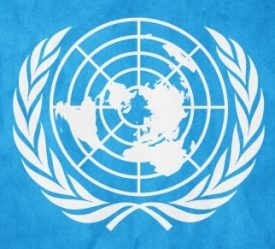
The UN Starts a Conservation Treaty for the High Seas
The nations of the world have launched a historic two-year process to create the first-ever international treaty to protect life in the high seas. Covering nearly half of the planet, the high seas are international waters where no country has jurisdiction. These waters, which reach depths of nearly seven miles, are filled with life, from valuable fish to plankton. They help generate the oxygen we breathe and regulate the global climate. “This is a once-in-a-generation opportunity to get ocean governance that puts conservation and sustainable use first,” says Liz Karan, senior manager for the high seas program at the Pew Charitable Trusts. click here to read the story 16:19
Fishermen support reversing marine monument designation
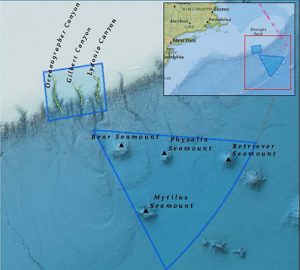 There’s a rich fishing ground a couple of hundred miles offshore used by fishermen from all over the East Coast called the Northeast Canyons. All kinds of commercial fish gather in the plankton-rich waters — from tuna to butterfish, from lobster to squid. “We have probably half our fleet that does all kinds of fishing out there,” said Rich Fuka of the Rhode Island Fishermen’s Alliance. It’s also a distinctive marine environment, with ancient coral and steep canyons.,,, Fuka said nets don’t go deep enough to affect coral and that “the fishermen are well-schooled and well-rehearsed and always participate in anything that has to do with migratory species like mammals, whales, they avoid them.”He pointed out the competition for fishing grounds now also includes offshore wind farms,, click here to read the story 10:34
There’s a rich fishing ground a couple of hundred miles offshore used by fishermen from all over the East Coast called the Northeast Canyons. All kinds of commercial fish gather in the plankton-rich waters — from tuna to butterfish, from lobster to squid. “We have probably half our fleet that does all kinds of fishing out there,” said Rich Fuka of the Rhode Island Fishermen’s Alliance. It’s also a distinctive marine environment, with ancient coral and steep canyons.,,, Fuka said nets don’t go deep enough to affect coral and that “the fishermen are well-schooled and well-rehearsed and always participate in anything that has to do with migratory species like mammals, whales, they avoid them.”He pointed out the competition for fishing grounds now also includes offshore wind farms,, click here to read the story 10:34
FISH-NL calls on C-NLOPB to suspend seismic work in light of potential impact on basis of marine food chain
 FOR IMMEDIATE RELEASE June 30th, 2017
FOR IMMEDIATE RELEASE June 30th, 2017
The Federation of Independent Sea Harvesters of Newfoundland and Labrador (FISH-NL) has requested that the C-NLOPB immediately suspend seismic work off Newfoundland and Labrador in light of a new study that found the intense acoustic signals may damage critical elements of the marine food chain.
“With most commercial fish stocks at or near critical levels our first priority must be the health of our renewable marine resources,” says Ryan Cleary, President of FISH-NL, who made the request Thursday in a letter to Scott Tessier, chair and executive officer of the C-NLOPB.
“The potential impact of seismic testing on the marine environment — combined with a potential conflict of interest in which the best interests of inshore harvesters may not be represented — should compel the C-NLOPB to act,” Cleary wrote in the letter.
The amount of seismic scheduled for 2017 has been described in the media as “super-sized.” Natural Resources Minister Siobhan Coady has said the 3D program is “one of the largest currently underway in the world”, and the 2D program is “unrivalled” in the modern exploration era.
At the same time, a study released earlier this month in the journal Nature Ecology & Evolution concluded that intense acoustic signals used in oil and gas exploration cause significant damage to zooplankton populations that are critical elements of the marine food chain.
The findings are concerning, because zooplankton — which include worms, crustaceans like krill, and many other tiny animals that drift near the ocean surface — provide sustenance for species higher in the food chain. Healthy populations of fish, for example, aren’t possible without them.
Local fish harvesters have long expressed concern of the potential impact of seismic blasting on the larva of various fish species that are found throughout the water column.
Given that most commercial stocks such as shrimp and cod are at or near critical levels, FISH-NL recommends that the C-NLPB proceed with extreme caution and immediately suspend seismic work off Newfoundland and Labrador until the activity can be reevaluated.
FISH-NL also expressed concern to the C-NLOPB over the FFAW-Unifor’s “cozy” relationship with offshore oil companies. Questions have been raised about the amount of money the oil industry contributes to the FFAW-Unifor, which the union won’t reveal.
The conflict of interest, real or perceived, undermines the faith of harvesters in the established powers that be to ensure that the health of marine resources is the highest priority.
The FFAW-Unifor is generally seen as quiet regarding the offshore oil industry’s exploration and drilling activities off Newfoundland and Labrador, which, for many inshore harvesters, begs the question why.
The former Obama administration in the U.S. had blocked seismic testing for oil in the Atlantic Ocean, but President Donald Trump is set to allow it — to growing opposition from environmental groups.
Some experts say seismic testing off the U.S., which would map potential driving sites from Delaware to central Florida, could harm thousands of animals and affect coastal communities.
More than 100 East Coast cities and towns, a range of commercial and recreational fishing groups and an alliance representing nearly 40,000 businesses have publicly opposed air-gun blasting
Contact: Ryan Cleary 682 4862
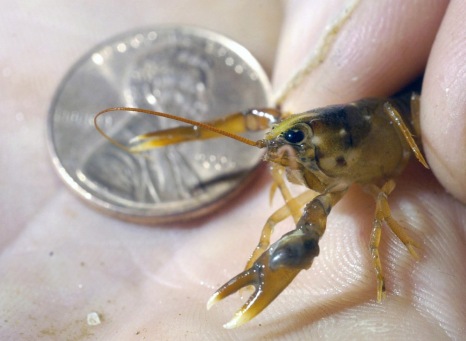
A mystery is born: Where are all the baby lobsters?
Biologists and lobstermen are growing increasingly worried that the state’s most valuable fishery, which in recent years has boasted record volume and value and accounts for more than 80 percent of Maine’s fishing profit, is about to go bust, a doomsday economic scenario some call the curse of the “gilded trap.” At the center of their concern: The number of baby lobsters found in the Gulf of Maine continues to fall. “We call it the great disconnect,” said Joshua Carloni, New Hampshire’s state lobster biologist. “And as you can imagine, it has us concerned.”,,, The Seabrook tows found a decline in copepods – tiny planktonic crustaceans that are most likely a staple of the lobster larval diet click here to read the story 08:14
Fish in the Northwest Atlantic Are Going Hungry – New Science From Maine’s Department of Marine Resources Helps To Explain Why. click here to read the article
Trap Gear Closure Lifted; Right Whales Leaving Cape Cod Bay
 The trap closure extension in Cape Cod Bay has been lifted effective Friday May 5 because nearly all the whales that were aggregated in Cape Cod Bay have departed as expected. DMF filed emergency regulations last week to extend the prohibition of trap gear within certain waters of Cape Cod Bay. This closure extension was enacted because in mid-April there was an unprecedented aggregation of over 200 right whales feeding on dense plankton, and more than 100 remained just days before the scheduled May 1 opening. Feeding right whales are susceptible to entanglement in vertical buoy lines. click here to read the notice 22:55
The trap closure extension in Cape Cod Bay has been lifted effective Friday May 5 because nearly all the whales that were aggregated in Cape Cod Bay have departed as expected. DMF filed emergency regulations last week to extend the prohibition of trap gear within certain waters of Cape Cod Bay. This closure extension was enacted because in mid-April there was an unprecedented aggregation of over 200 right whales feeding on dense plankton, and more than 100 remained just days before the scheduled May 1 opening. Feeding right whales are susceptible to entanglement in vertical buoy lines. click here to read the notice 22:55
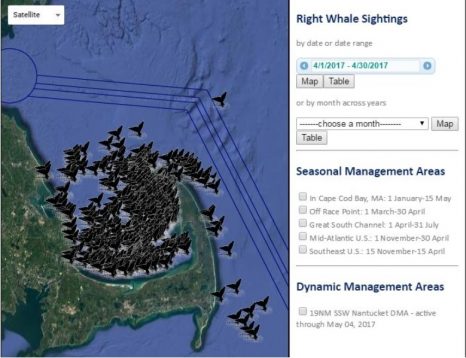
No lobstering until right whales leave Cape Cod Bay
For the past three years there has been a ban on setting lobster traps and pots in the bay from Feb. 1 through the end of April, a ban intended to protect these whales from entanglement. Last week by some counts close to 200 of the estimated total population of 500 Atlantic Western Right Whales were still in Cape Cod Bay. Citing their endangered status and their surprising willingness to stay in the bay because of an abundance of the plankton they feed on, the state’s Division of Marine Fisheries announced that most of the bay would remain closed to setting recreational and commercial lobster traps and pots through next Sunday, May 7. For environmentalists involved in the protection of this species of whale the extended ban was a reasonable, measured action. For many lobstermen it was salt on an open wound. click here to read the story 07:56
When Alaska shellfish turns deadly – Paralytic Shellfish Poisoning
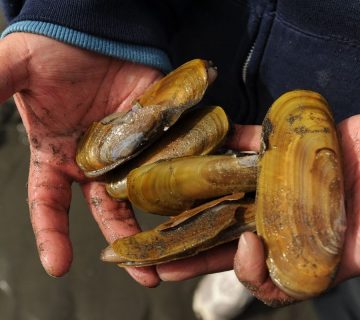 In the Alaska wilderness, at least you can see the things that’ll kill you. That’s what I say when I get tired of questions about bears. But it’s not true. The smallest things that can kill you here are single-celled creatures you need a microscope to see. They can find their way into the food chain, into your clam bucket, your chowder, and then into your nerve cells. Minutes or hours later, you tingle or go numb. Nerve cells shut down in a rapid cascade until you lose control over limbs and lungs. This is paralytic shellfish poisoning, or PSP. It comes from a tiny species of plankton called Alexandrium, which produces an even tinier chemical called saxitoxin, which is a thousand times more toxic than sarin gas, and was once studied as part of our biological weapons program in the 1950s and 1960s. click here to read the story 09:00
In the Alaska wilderness, at least you can see the things that’ll kill you. That’s what I say when I get tired of questions about bears. But it’s not true. The smallest things that can kill you here are single-celled creatures you need a microscope to see. They can find their way into the food chain, into your clam bucket, your chowder, and then into your nerve cells. Minutes or hours later, you tingle or go numb. Nerve cells shut down in a rapid cascade until you lose control over limbs and lungs. This is paralytic shellfish poisoning, or PSP. It comes from a tiny species of plankton called Alexandrium, which produces an even tinier chemical called saxitoxin, which is a thousand times more toxic than sarin gas, and was once studied as part of our biological weapons program in the 1950s and 1960s. click here to read the story 09:00
Division of Marine Fisheries Extends Trap Fishing Gear Closure in Cape Cod Bay
 As a result of the ongoing presence of endangered right whales feeding in Cape Cod Bay, the Division of Marine Fisheries (DMF) today announced that most of Cape Cod Bay will remain closed to the setting of recreational and commercial traps and pots for an additional week, through May 7, 2017. Right whales are common in Cape Cod Bay during late winter and early spring, especially during the months of March and April, and usually depart before May 1, when the three month (February – April) trap closure affecting this area was scheduled to be lifted. However, over the past month an unprecedented number of whales have been observed, with mid-April counts demonstrating a presence of more than 200 whales. While the most recent survey suggests some whales may have departed the Bay, an estimated 100 to 200 individuals remain present. This late seasonal presence of whales corresponds with extraordinarily high densities of plankton (Calanus copepods), the preferred food of right whales. Read the press release here with imagery 14:43
As a result of the ongoing presence of endangered right whales feeding in Cape Cod Bay, the Division of Marine Fisheries (DMF) today announced that most of Cape Cod Bay will remain closed to the setting of recreational and commercial traps and pots for an additional week, through May 7, 2017. Right whales are common in Cape Cod Bay during late winter and early spring, especially during the months of March and April, and usually depart before May 1, when the three month (February – April) trap closure affecting this area was scheduled to be lifted. However, over the past month an unprecedented number of whales have been observed, with mid-April counts demonstrating a presence of more than 200 whales. While the most recent survey suggests some whales may have departed the Bay, an estimated 100 to 200 individuals remain present. This late seasonal presence of whales corresponds with extraordinarily high densities of plankton (Calanus copepods), the preferred food of right whales. Read the press release here with imagery 14:43
Division of Marine Fisheries Extends Trap Fishing Gear Closure in Cape Cod Bay
As a result of the ongoing presence of endangered right whales feeding in Cape Cod Bay, the Division of Marine Fisheries (DMF) today announced that most of Cape Cod Bay will remain closed to the setting of recreational and commercial traps and pots for an additional week, through May 7, 2017.
Right whales are common in Cape Cod Bay during late winter and early spring, especially during the months of March and April, and usually depart before May 1, when the three month (February – April) trap
closure affecting this area was scheduled to be lifted. However, over the past month an unprecedented number of whales have been observed, with mid-April counts demonstrating a presence of more than 200 whales. While the most recent survey suggests some whales may have departed the Bay, an estimated 100 to 200 individuals remain present. This late seasonal presence of whales corresponds with extraordinarily high densities of plankton (Calanus copepods), the preferred food of right whales.
The area affected by the closure is depicted in the map below and its northern border is bound by the following points:
|
Point |
Latitude |
Longitude |
|
A |
41°35’44.02” |
70°35’44.02” |
|
B |
42°0’20.15” |
70°35’56.79” |
|
C |
42°6’56.4” |
70°16’29.14” |
|
D |
42°4’53.83” |
70°10’26.96” |
The Center for Coastal Studies is completing its 21st annual survey under contract to MarineFisheries funded by the National Oceanic and Atmospheric Administration and the Massachusetts Environmental Trust. Based on survey’s historical patterns of whale distribution and abundance in the bay, the whales are expected to depart in early May. Regular surveillance flights by the Center will allow MarineFisheries to monitor the situation. If whales depart early or change their distribution, the closure will be rescinded or modified to ease the burden on commercial and recreational lobstermen.
Because these right whales are intensely feeding near the surface they can be somewhat oblivious to their surroundings and are highly vulnerable to entanglements in vertical buoy lines as well as vessel strikes. All mariners should be cautious and avoid transiting the area in excess of 10 knots. Additionally, it is unlawful to approach within 500 yards of a right whale or to harass or harm any right whale. If you observe a right whale entangled in fishing gear while on the water, report it immediately to the Center for Coastal Studies (800-900-3622), the state Office of Environmental Law Enforcement (800-632-8075) or the federal Entanglement Hot Line: (866-755-6622).
For more information about the closure, contact Division of Marine Fisheries Deputy Director Dan McKiernan at (617) 626-1536 or [email protected], or Erin Burke at (508) 990-2860 extension 142. Individuals are also encouraged to visit the Division of Marine Fisheries’ website.
Japan embraces Russ George’s scheme for iron fertilization
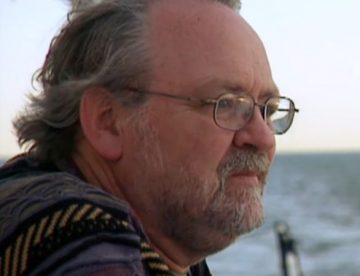 Russ George is semi-famous for dumping over 100 metric tons of iron dust, iron sulfate fertilizer and iron oxide into the sea off British Columbia, Canada in 2012. The act, he claims, spurred a plankton bloom that fed a huge surge in pink salmon returns the following year and in chum salmon returns in 2016 – the difference in years reflecting the different lifecycles of the species. The plan sought to replicate the effect of the eruption of Kasatochi volcano in the Aleutians, which also deposited iron-rich dust and spurred a plankton bloom. Sequestering carbon – in the hard shells of diatoms that sink to the ocean floor – was a supposed secondary benefit. However, George’s experiment, undertaken with the backing of a Native American (First Nations) group, the Haida in the village of Old Masset, and carried out as a corporate activity of the “Haida Salmon Restoration Corporation,” was deemed a rogue experiment. click here to read the story 15:36 click here to read “Japanese Salmon Fisheries In Historic Collapse Help On The Way” 15:40
Russ George is semi-famous for dumping over 100 metric tons of iron dust, iron sulfate fertilizer and iron oxide into the sea off British Columbia, Canada in 2012. The act, he claims, spurred a plankton bloom that fed a huge surge in pink salmon returns the following year and in chum salmon returns in 2016 – the difference in years reflecting the different lifecycles of the species. The plan sought to replicate the effect of the eruption of Kasatochi volcano in the Aleutians, which also deposited iron-rich dust and spurred a plankton bloom. Sequestering carbon – in the hard shells of diatoms that sink to the ocean floor – was a supposed secondary benefit. However, George’s experiment, undertaken with the backing of a Native American (First Nations) group, the Haida in the village of Old Masset, and carried out as a corporate activity of the “Haida Salmon Restoration Corporation,” was deemed a rogue experiment. click here to read the story 15:36 click here to read “Japanese Salmon Fisheries In Historic Collapse Help On The Way” 15:40
White spot threat: is fishing finished in Queensland?
 The Logan River white spot epidemic could destroy all mainland fishing in Queensland, including a big slice of the Cooloola Coast seafood and tourism economy, industry leader Kev Reibel has warned. A Queensland Seafood Industry Association board member and Tin Can Bay trawler operator, Mr Reibel said the threat was credible and immediate. “To say we are worried would be something of an understatement,” he said in an exclusive interview with The Gympie Times on Sunday. “We don’t know if it can be stopped and we don’t know its boundaries within the crustaceans, or even if it has any boundaries. If it affects crabs, that’s another industry and another tourism factor wiped out. He backed claims by industry environmental adviser and Bay net fishing operator Joe McLeod that the apparently unstoppable virus is a threat to the food chains which sustain all kinds of fin fishing. Mr McLeod said the plankton that kicked off the fin fish food chain included juvenile prawns and other crustaceans. “If they’re not there, there is nothing for the fish to eat,” Mr McLeod said yesterday. Both said there was a fearful lack of knowledge of the virus’ boundaries, especially with the crustacean group. Continue reading the story here 09:32
The Logan River white spot epidemic could destroy all mainland fishing in Queensland, including a big slice of the Cooloola Coast seafood and tourism economy, industry leader Kev Reibel has warned. A Queensland Seafood Industry Association board member and Tin Can Bay trawler operator, Mr Reibel said the threat was credible and immediate. “To say we are worried would be something of an understatement,” he said in an exclusive interview with The Gympie Times on Sunday. “We don’t know if it can be stopped and we don’t know its boundaries within the crustaceans, or even if it has any boundaries. If it affects crabs, that’s another industry and another tourism factor wiped out. He backed claims by industry environmental adviser and Bay net fishing operator Joe McLeod that the apparently unstoppable virus is a threat to the food chains which sustain all kinds of fin fishing. Mr McLeod said the plankton that kicked off the fin fish food chain included juvenile prawns and other crustaceans. “If they’re not there, there is nothing for the fish to eat,” Mr McLeod said yesterday. Both said there was a fearful lack of knowledge of the virus’ boundaries, especially with the crustacean group. Continue reading the story here 09:32
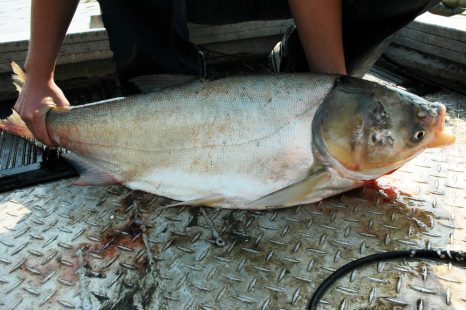
REWARD!! Michigan DNR Offers Big Reward For Plan To Block Invasive Fish
If the fishing world had a most-wanted list, Asian carp surely top it. There are plenty of despised invasives plaguing U.S. waters, but how many of them have a $1 million dollar bounty on their heads? That’s what the Michigan Department of Natural Resources just dropped on the table. Show the agency a viable plan for stopping those silver and big head carp from reaching the Great Lakes and you could be eligible for a sweet payday. In case you haven’t already heard the tale, Asian carp are prolific breeders that can reach 50-pounds. The filter-feeding invasives consume massive amounts of the tiny plants (phytoplankton) and animals (zooplankton) that feed native forage species, along with juvenile sport fish such as walleye and yellow perch. Disrupting the food web can wreak havoc on local fisheries. Read the story here with link to DNR 12:21
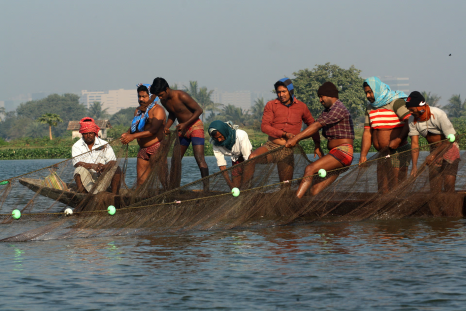
Kolkata: the city that eats fish reared on untreated wastewater sewage
It all started as an accident, if you believe the story that the fishermen of the east Kolkata wetlands tell. Around a century ago, a cultivator named Bidu Sarkar accidentally allowed untreated wastewater from Kolkata’s sewage pipes into his fish pond. Realising what had happened, Sarkar expected disaster. Instead of killing his fish, however, the water doubled his yields. When fishermen from the surrounding area came to find out more, they discovered that the combination of sewage in the water and sunshine broke down the effluent and allowed plankton, which fish feed on, to grow exponentially. Soon thousands of fish farmers had set up bheris, or fishponds, across 12,500 hectares on the eastern fringes of the city. Today, according to Dr Partha Prathim Chakrabarti, principal scientist at the Central Institute of Freshwater Aquaculture, the east Kolkata wetlands provide a living for some 50,000 cultivators and fish traders, most of them small-time private entrepreneurs who earn an income rearing 10,000 tonnes of wastewater-fed fish a year. Read the story here 09:50
FOR IMMEDIATE RELEASE: Division of Marine Fisheries Reopens Waters South of Cape Cod to Shellfishing
 Effective immediately, the Division of Marine Fisheries (DMF) has reopened waters south of Cape Cod to shellfish harvesting, including Mount Hope Bay, Buzzards Bay, Vineyard Sound, Nantucket Sound, the islands of Martha’s Vineyard and Nantucket, and the south coast of Cape Cod. Due to the dissipation of a potentially toxic phytoplankton bloom of Pseudo-Nitzshia and the results of toxicity testing, DMF has concluded that shellfish in the reopened areas are safe to harvest for public consumption.Toxicity screening of shellfish was conducted by DMF laboratories and the Bigelow Laboratory for Ocean Sciences in Maine, and results have determined that digging, harvesting, collecting and/or attempting to dig, harvest or collect shellfish, and the possession of shellfish, is now permissible in all approved or conditionally approved waters from the Rhode Island border east into Nantucket Sound, including all of Vineyard and Nantucket Sounds and waters surrounding the islands. DMF issued a shellfish harvest closure in Buzzards Bay, Mount Hope Bay and Lackeys Bay on October 7, 2016 and issued a closure in all waters south of Cape Cod on October 9, 2016. Shellfish closure notices can be found on the DMF website. 12:54
Effective immediately, the Division of Marine Fisheries (DMF) has reopened waters south of Cape Cod to shellfish harvesting, including Mount Hope Bay, Buzzards Bay, Vineyard Sound, Nantucket Sound, the islands of Martha’s Vineyard and Nantucket, and the south coast of Cape Cod. Due to the dissipation of a potentially toxic phytoplankton bloom of Pseudo-Nitzshia and the results of toxicity testing, DMF has concluded that shellfish in the reopened areas are safe to harvest for public consumption.Toxicity screening of shellfish was conducted by DMF laboratories and the Bigelow Laboratory for Ocean Sciences in Maine, and results have determined that digging, harvesting, collecting and/or attempting to dig, harvest or collect shellfish, and the possession of shellfish, is now permissible in all approved or conditionally approved waters from the Rhode Island border east into Nantucket Sound, including all of Vineyard and Nantucket Sounds and waters surrounding the islands. DMF issued a shellfish harvest closure in Buzzards Bay, Mount Hope Bay and Lackeys Bay on October 7, 2016 and issued a closure in all waters south of Cape Cod on October 9, 2016. Shellfish closure notices can be found on the DMF website. 12:54
Shellfish harvested from RI waters test negative for toxins
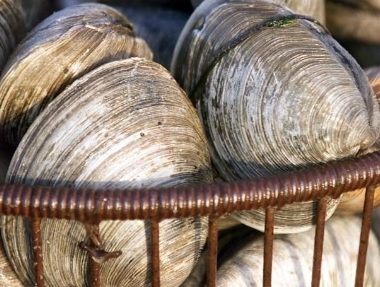 While Rhode Island’s shellfishing industry is still on hold as toxin levels in area waters remain high, the Rhode Island Department of Environmental Management reported Friday that shellfish meat tested negative for toxic phytoplankton. “Every time we have found toxicity in the water column, we’ve never found it in the shellfish,” Angelo Liberti of the Rhode Island Department of Environmental Management told NBC 10 News. A harmful algae bloom forced a precautionary closure of Narragansett Bay, Mt. Hope Bay, Kickemuit River, Sakonnet River, as well as their tributaries, on Oct. 6 and Oct. 7. Authorities hope that the shellfishing industry will be fully operational again soon. That’s good news for shellfishermen, who have been out of work since the closure was enacted. If the remaining shellfish samples come back negative, they could be back in business as soon as next week. Read the story here 15:05
While Rhode Island’s shellfishing industry is still on hold as toxin levels in area waters remain high, the Rhode Island Department of Environmental Management reported Friday that shellfish meat tested negative for toxic phytoplankton. “Every time we have found toxicity in the water column, we’ve never found it in the shellfish,” Angelo Liberti of the Rhode Island Department of Environmental Management told NBC 10 News. A harmful algae bloom forced a precautionary closure of Narragansett Bay, Mt. Hope Bay, Kickemuit River, Sakonnet River, as well as their tributaries, on Oct. 6 and Oct. 7. Authorities hope that the shellfishing industry will be fully operational again soon. That’s good news for shellfishermen, who have been out of work since the closure was enacted. If the remaining shellfish samples come back negative, they could be back in business as soon as next week. Read the story here 15:05
Declining biotoxin levels – Some Down East shellfishing areas reopened
On Thursday, the Department of Marine Resources re-opened some of the coastline between Calais and Cutler for the harvest of clams, mussels and carnivorous snails, and said clamming will be allowed on a portion of the coast between Isle Au Haut to Winter Harbor. Shellfish harvesting on much of the Down East coast remains restricted because of an algae bloom that produces a toxin that can cause amnesic shellfish poisoning, or ASP, in humans. It is unclear if the limited reopening Thursday means the bloom is clearing up or if harvesting bans will be removed in other areas soon. “We can’t speculate, but we continue to test shellfish and phytoplankton along the coast, both inside and outside the impacted areas, and will re-open areas as soon as test results allow,” said Jeff Nichols, a spokesman for the department of Marine Resources. Lifting the emergency restrictions was a relief to clammers who have been kept off the flats for the last two weeks. Read the story here 08:32
of the coastline between Calais and Cutler for the harvest of clams, mussels and carnivorous snails, and said clamming will be allowed on a portion of the coast between Isle Au Haut to Winter Harbor. Shellfish harvesting on much of the Down East coast remains restricted because of an algae bloom that produces a toxin that can cause amnesic shellfish poisoning, or ASP, in humans. It is unclear if the limited reopening Thursday means the bloom is clearing up or if harvesting bans will be removed in other areas soon. “We can’t speculate, but we continue to test shellfish and phytoplankton along the coast, both inside and outside the impacted areas, and will re-open areas as soon as test results allow,” said Jeff Nichols, a spokesman for the department of Marine Resources. Lifting the emergency restrictions was a relief to clammers who have been kept off the flats for the last two weeks. Read the story here 08:32
First in Maine, Now in Massachusetts. Toxic algae outbreak halts shellfishing in Buzzards Bay, Mount Hope Bay
 The state’s Division of Marine Fisheries has banned shellfishing in the west side of Buzzards Bay and in Mount Hope Bay because of a breakout of toxic algae late last week. The ban affects all SouthCoast towns and cities. “As a result of the closure, digging, harvesting, collecting and/or attempting to dig, harvest or collect shellfish, and the possession of shellfish, is prohibited in Bourne, Dartmouth, Fairhaven, Falmouth, Gosnold, Marion, Mattapoisett, New Bedford, Swansea and Westport,” the state said in a press release. The trouble concerns a toxic kind of phytoplankton termed Pseudo-Nitzschia. This algae can produce domoic acid, a biotoxin that concentrates in filter-feeding shellfish. Read the story here 08:37
The state’s Division of Marine Fisheries has banned shellfishing in the west side of Buzzards Bay and in Mount Hope Bay because of a breakout of toxic algae late last week. The ban affects all SouthCoast towns and cities. “As a result of the closure, digging, harvesting, collecting and/or attempting to dig, harvest or collect shellfish, and the possession of shellfish, is prohibited in Bourne, Dartmouth, Fairhaven, Falmouth, Gosnold, Marion, Mattapoisett, New Bedford, Swansea and Westport,” the state said in a press release. The trouble concerns a toxic kind of phytoplankton termed Pseudo-Nitzschia. This algae can produce domoic acid, a biotoxin that concentrates in filter-feeding shellfish. Read the story here 08:37
When it comes to fish and fishing Huffington Post is all wet
When it comes to fish and fishing Huffington Post is all wet
Nils E. Stolpe/FishNet USA August 14, 2016
Last week Dana Ellis Hunnes, a Huffington Post blogger, managed to package in just 700 words more false, misleading, distorted and just plain wrong information about fish and seafood production than I’ve ever seen in works with far more words by professional anti-fishing activists. Addressing her inaccuracies on a point by point basis:
____________________
- Sustainable Fish Do Not Exist
Starting out with her title, the Merriam-Webster definition of sustainable is “able to be used without being completely used up or destroyed, involving methods that do not completely use up or destroy natural resources, able to last or continue for a long time.” The concept of renewable resources revolves around the sustainable utilization of those resources.
In 2014, according to the United Nation’s Food and Agriculture Organization, the United States was ranked number three in the production of its capture fisheries in the world (behind China and Indonesia). The federal fisheries management system, as set forth in the Magnuson-Stevens Fishery Conservation and Management Act, has sustainability as its primary focus. Overfished fish stocks are those that are harvested at an unsustainable level and the Act demands that fishing effort on overfished stocks be reduced to the level of sustainability (also known as the maximum sustainable yield or MSY). In 2015 only nine percent of U.S. fish stocks were being fished at an unsustainable level –http://www.nmfs.noaa.gov/sfa/fisheries_eco/status_of_fisheries/.
Note that as defined in the Magnuson Act “overfished” does not necessarily mean too much fishing, it means that there are not as many fish in a stock as fishery scientist think should be there regardless of the cause
By any definition of sustainability that is used (except for Ms. Hunnes’), nine out of ten of our fisheries, and more than 90% of the fish that we harvest, are inarguably sustainable.
____________________
- In fact, the United Nations Environmental Programme and Food and Agriculture Organization, report that we are running out of fish. We have overfished or overexploited more than 80% of our fish stocks.
The Food and Agriculture Organization of the United Nations (FAO) in its 2016 The State of World Fisheries and Aquaculture reported “fully fished stocks accounted for 58.1 percent (of the world’s capture fisheries) and underfished stocks 10.5 percent.” (http://www.fao.org/3/a-i5555e.pdf on Pg. 5). Fully fished stocks are those that are being harvested at their MSY. So, in spite of what Ms. Hunnes wrote in the Huffington Post, almost 70% of the fish stocks in the world are being harvested sustainably. That is a far cry from “running out of fish.” As the graph below (from Pg. 13 of the same FAO report cited above) demonstrates, the production of the world’s capture fisheries has been level since the late 1980s. I could find nothing on the FAO website that even hinted that there was any indication that we were “running out of fish.”
- In fact, a number of the species have been declared as critically endangered and threatened with extinction by the International Union on the Conservation of Nature (IUCN).
In spite of IUCN declarations, in the U.S. Fish and Wildlife Service Environmental Conservation Online System, listing animal species that are Endangered or Threatened in the U.S. and abroad (http://preview.tinyurl.com/zl3qgk3),
the only fish listed that support commercial fisheries are geographically distinct groups of salmon (threatened or endangered because of anthropogenic impacts on their spawning grounds, not fishing – see note above). None of those salmon species are considered endangered or threatened throughout their range. Some species of sturgeon are listed throughout their range as are some distinct population segments of others, but no commercial sturgeon fisheries are permitted in the U.S. The same for sawfish. The rest of the listed threatened or endangered species are species of no commercial interest.
____________________
- And, while we may believe that consuming farmed fish is a more sustainable and ecological choice….
Any definition of “sustainable” that I’m aware of indicates that it’s an all or nothing term. Something is either utilized sustainably or it isn’t. Ms. Hunnes’ use of “more sustainable” is linguistically puzzling. “Ecological” relates to or is concerned with the study of organisms in relation to each other and to their living and non-living environment. The idea of applying the term to a dietary choice is even more linguistically puzzling than “more sustainable.”
But, the niceties of effective communications aside, there are numerous ways to grow fish and to catch fish. Some are – or should be – unacceptable because of the damage they do to the environment. It’s the role of government to insure that these are not permitted, and in the U.S. they aren’t. Other methods of fish production in the U.S. and in much of the rest of the world are environmentally acceptable and are permitted, though highly regulated.
____________________
- It takes approximately five pounds of wild small fish such as herring, menhaden, or anchovies to create one pound of salmon, a predatory fish. The proportion of the healthy omega-3 fatty acids found in salmon is lower pound-for-pound than it would be simply in the smaller fish.
This is a generalization that, like many generalizations, doesn’t hold up under scrutiny. The DHA and EPA (respectively docosahexaenoic acid and eicosapentaenoic acid, fish-derived omega 3 fatty acids) content of the flesh of particular fish as determined by the US Departments of Agriculture and Health and Human Services are below.
| Fish, salmon, Atlantic, farmed, cooked, dry heat | 2.147 grams DHA and EPA/100 grams |
| Fish, anchovy, European, raw | 1.449 g/100g |
| Fish, anchovy, European, canned in oil, drained solids | 2.055 g/100g |
| Fish, herring, Atlantic, cooked, dry heat | 2.014 g/100 g |
(https://health.gov/dietaryguidelines/dga2005/report/html/table_g2_adda2.htm)
I couldn’t find equivalent data for menhaden, and I sincerely hope that anyone reading this never has to dine on them, but because of similar diets their fatty acid content is almost certainly in line with that of Atlantic herring.
- Current statistical analyses and estimates indicate that in a “business as usual” world, we will run out of the fish we eat by 2048
In 2006 Canadian fisheries researcher Boris Worm and a group of scientists published a paper in the journal Science predicting that the continuation of present trends would mean that all of the big fish in the oceans would be gone by 2048. Needless to say, this prediction generated a media storm and much scientific controversy, which the media ignored. Unfortunately, a casual web search will provide links to the dire prediction that Ms. Hunnes focused on.
But she was off by at least a decade with what she refers to as “current statistical analyses.” In fact, in 2009 Worm and University of Washington Fisheries Professor Ray Hilborn and a group of other researchers published a follow-up paper that soundly rejected the 2006 prediction of the imminent destruction of the world’s fisheries. (http://www.nature.com/news/2009/090730/full/news.2009.751.html)
_______________
- But the fact of the matter is, it’s near impossible to grow or to take a fish in a sustainable way. In a way, nearly every fish humans eat is threatened with extinction.
It’s hard to imagine in exactly what way that would be, and unfortunately Ms. Hunnes didn’t share her insights on this with her readers. She could have just as easily written in a way, nearly every cow (or pig or goat or string bean or ear of corn) humans eat is threatened with extinction. The whole point of sustainable food production is to not eat more than is being produced. That covers a very large proportion of our seafood and that proportion increases every year.
____________________
- Never order bluefin tuna. It would be akin to eating a rhinoceros.
According to the USFWS bluefin tuna are not classified as endangered or threatened – in spite of an ongoing campaign by anti-fishing zealots to have them listed as such. Accordingly, if it’s legally caught and legally sold, ordering bluefin tuna is akin to ordering a beef steak, though the tuna is much healthier. But in keeping with the old adage “even a blind squirrel finds the occasional acorn,” Ms Hunnes was right about rhinoceroses. They definitely shouldn’t be eaten.
____________________
- If you are going to eat fish, consume the small ones. The anchovies, the herring; the bottom of the food chain.
The bottom of the ocean food chain is composed of plants, almost exclusively algae and almost exclusively planktonic. The “small ones” Ms. Hunnes is referring to are a couple of steps up the food chain from there.
____________________
- Skip that fish oil. You don’t need it, there’s no real benefit, and you can get those healthy oils from other foods including algal oils, flaxseed, seeds and nuts.
The pros and cons of dietary fish oil, or more precisely of omega 3 fatty acids, and of the relative health benefits of omega 3s produced by oceanic algae and found in oceanic fish vs the health benefits of omega 3s produced by terrestrial plants, has been going on for more than a decade. There’s nothing approaching a scientific consensus as yet, except perhaps in Ms. Hunnes’ mind. For the other side of the argument take a look at The Best Omega-3 Supplement: Flaxseed Oil vs. Fish Oil on the University Health News website at http://universityhealthnews.com/daily/nutrition/the-best-omega-3-supplement-flaxseed-oil-vs-fish-oil/.
And from the Tufts University Health and Nutrition Newsletter (January 2012 Issue)
Question: As a vegetarian, can I get enough omega-3 from walnuts, flax seed, canola oil and trace amounts in other foods?
Answer: The omega-3 fatty acids found in plant foods (ALA) have their own health benefits, but they are not the same as the omega-3s found in fish (DHA and EPA) that have been associated with heart-health benefits. According to Alice H. Lichtenstein, DSc, director of Tufts’ HNRCA Cardiovascular Nutrition Laboratory, while your body does convert ALA into DHA/EPA, studies have found that this conversion is very inefficient. Only between 3% and 5% of the ALA gets converted into EPA and as little as 0.5% to 9% into DHA. If you’re concerned about getting enough of the omega-3s found in fish, it is possible to buy vegetarian supplements that derive DHA from algae. (http://www.nutritionletter.tufts.edu/issues/8_1/ask-experts/ask-tufts-experts_1173-1.html)
____________________
- Confirm that it is not an endangered species simply renamed for marketing purposes.
The federal Food and Drug Administration has a list of common and scientific names of fish and shellfish called the Seafood List, which is regularly updated. More properly the Guide to Acceptable Market Names for Seafood, it’s available at http://preview.tinyurl.com/jaffa33, it’s quite extensive, and reputable seafood dealers and restaurateurs adhere to its content. But above and beyond the Seafood List, the probability of an endangered – or a threatened – species making its way to any retail markets or restaurants which don’t follow federal and state laws is remote. The probability of buying an endangered species of fish or shellfish from a fish market would be approaching the probability of buying a rhinoceros roast from a butcher.
There has been a problem with misidentified species, but this involves either mislabeling a less expensive product as a more expensive one or concealing where the seafood originated to circumvent import restrictions. Curtailing this misidentification was recently made a federal priority (see http://www.iuufishing.noaa.gov/) .
____________________
In sum it appears as if Ms. Hunnes is not a fan of seafood in the human diet. And she appears to have fully embraced every doom and gloom report she stumbled upon in researching this blog, selecting the worst of the worst. But by looking just the slightest bit behind the headlines she would have found that much of the worst that she has embraced is not justified. I would think that her readers deserve better.
With a world population of over seven billion no one who wasn’t suffering from some level of misanthropy could have a problem with 60 percent of our fisheries being fully and sustainably exploited (though they might not look with favor at the 10 percent that aren’t), but somehow Ms. Hunnes insists that there’s no such thing as a sustainable fishery. Perhaps in another blog she’ll explain how she arrived at that conclusion and set the world of fishing and fishery management straight, because an awful lot of people believe in, an awful lot more people depend on and even more people than that both enjoy and benefit from sustainably grown and sustainably harvested fish and shellfish.
_______________
“This significant growth in fish consumption has enhanced people’s diets around the world through diversified and nutritious food. In 2013, fish accounted for about 17 percent of the global population’s intake of animal protein and 6.7 percent of all protein consumed” (Pg. 4 of the FAO report cited above). This might be inconsequential to Ms Hunnes and the Huffington Post, but rest assured that to the people who depend on catching, processing, transporting, marketing and consuming these fish, it surely isn’t, and no alternative animal protein sources are very likely. Maybe their plan, like Marie Antoinette’s, is to let them eat cake instead,






